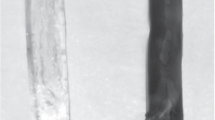Abstract
The feasibility of using aqueous suspensions of several metal oxide nanoparticles as contrast agents for ultrasonic cardiovascular visualization has been investigated. Nanopowders of Al, Fe, and Zr oxides were prepared by the electrical explosion of metallic wires, and characteristics such as particle size, specific area, and particle size distribution, were obtained, as were TEM photographs. Dynamic light-scattering data demonstrated that the aggregation of nanoparticles took place in their aqueous suspensions in the function of mean particle size. Acoustic properties of stable suspensions of nanopowders were studied in an experimental model of circulation with simultaneous measurements performed by a commercially available standard ultrasonic apparatus used in medical institutions. The results indicate that the intensity of the reflected echo signal depends on the chemical nature of the metal oxide and the structure of nanoparticles and aggregates that are formed in an aqueous medium. The presented data show the high ultrasonic echo activity of several metal oxides and, at the same time, form a scientific background for a better understanding of the interactions between nanoparticles and the ultrasonic wave.
Similar content being viewed by others
References
P. A. Dayton and K. W. Ferrara, “Targeted Imaging Using Ultrasound,” Magn. Reson. Imaging 16(4), 362–377 (2002).
S. R. Cherry, “In Vivo Molecular and Genomic Imaging: New Challenges for Imaging Physics,” Phys. Med. Biol. 49(3), 13–48 (2004).
M. J. K. Blomley, J. C. Cooke, E. C. Unger, M. J. Monaghan, and D. O. Cosgrove, “Microbubble Contrast Agents: A New Era in Ultrasound,” Br. Med. J. 322(7296), 1222–1225 (2001).
S. Qin and K. W. Ferrara, “Acoustic Response of Compliable Microvessels Containing Ultrasound Contrast Agents,” Phys. Med. Biol. 51(20), 5065–5088 (2006).
B. A. Kaufmann and J. R. Lindner, “Molecular Imaging with Targeted Contrast Ultrasound,” Curr. Opin. Biotechnol. 18(1), 11–16 (2007).
L. Zagorchev and M. J. Mulligan-Kehoea, “Molecular Imaging of Vessels in Mouse Models of Disease,” Eur. J. Radiol. 70(2), 305–311 (2009).
S. M. Demos, H. Önyüsel, J. Gilbert, S. I. Roth, B. Kane, P. Jungblut, J. V. Pinto, D. D. McPherson, and M. E. Klegerman, “In Vitro Targeting of Antibody-Conjugated Echogenic Liposomes for Site-Specific Ultrasonic Image Enhancement,” J. Pharm. Sci. 86(2), 167–171 (1997).
G. M. Lanza and S. A. Wickline, “Targeted Ultrasonic Contrast Agents for Molecular Imaging and Therapy,” Curr. Probl. Cardiol. 28(12), 625–653 (2003).
S. Kwon and M. A. Wheatley, “Development and Characterization of PLA Nanodispersion as a Potential Ultrasound Contrast Agent for Cancer Site Imaging,” in Proceedings of the IEEE 31st Annual Northeast Bioengineering Conference, the Stevens Institute of Technology, Hoboken, NJ, United States, April 2–3, 2005 (Hoboken, 2005), pp. 144–145.
C. Kollmann and M. Putzer, “Ultraschallkontrastmittel—physikalische Grundlagen (Ultrasound Contrast Agents—Physical Basics),” Radiologe 45(6), 503–512 (2005).
V. Sboros, “Response of Contrast Agents to Ultra-sound,” Adv. Drug Delivery Rev. 60(10), 1117–1136 (2008).
F. Calliada, R. Campani, O. Bottinelli, A. Bozzini, and M. G. Sommaruga, “Ultrasound Contrast Agents: Basic Principles,” Eur. J. Radiol. 27(Suppl. 2), S157–S160 (1998).
J. Cwajg, F. Xie, E. O’Leary, D. Kricsfeld, H. Dittrich, and T. R. Porter, “Detection of Angiographically Significant Coronary Artery Disease with Accelerated Intermittent Imaging after Intravenous Administration of Ultrasound Contrast Material,” Am. Heart J. 139(4), 675–683 (2000).
J. E. Chomas, P. Dayton, J. Allen, K. Morgan, and K.W. Ferrara, “Mechanisms of Contrast Agent Destruction,” IEEE Trans. Ultrason., Ferroelectr. Freq. Control 48(1), 232–248 (2001).
D. Vancraeynest, X. Havaux, A. Pasquet, B. Gerber, C. Beauloye, P. Rafter, L. Bertrand, and J.-L. Vanoverschelde, “Myocardial Injury Induced by Ultrasound-Targeted Microbubble Destruction: Evidence for the Contribution of Myocardial Ischemia,” Ultrasound Med. Biol. 35(4), 672–679 (2009).
J. Ophir, A. Gobuty, R. E. McWhirt, and N. F. Maklad, “Ultrasonic Backscatter from Contrast Producing Collagen Microspheres,” Ultrason. Imaging 2(1), 67–77 (1980).
K. J. Parker, T. A. Tuthill, R. M. Lerner, and M. R. Violante, “A Particulate Contrast Agent with Potential for Ultrasound Imaging of Liver,” Ultrasound Med. Biol. 13(9), 555–566 (1987).
Y-X. J. Wang, S. M. Hussain, and G. P. Krestin, “Superparamagnetic Iron Oxide Contrast Agents: Physicochemical Characteristics and Applications in MR Imaging,” Eur. J. Radiol. 11(11), 2319–2331 (2001).
A. Ito, M. Shinkai, H. Honda, and T. Kobayashi, “Medical Application of Functionalized Magnetic Nanoparticles,” J. Biosci. Bioeng. 100(1), 1–11 (2005).
J. Liu, A. L. Levine, J. S. Mattoon, M. Yamaguchi, R. J. Lee, X. Pan, and T. J. Rosol, “Nanoparticles as Image Enhancing Agents for Ultrasonography,” Phys. Med. Biol. 51(9), 2179–2189 (2006).
Yu. A. Kotov, “Electric Explosion of Wires as a Method for Preparation of Nanopowders,” J. Nanopart. Res. 5(5–6), 539–550 (2003).
Yu. A. Kotov, A. V. Bagazeev, A. I. Medvedev, A. M. Murzakaev, T. M. Demina, and A. K. Shtol’ts, “Characteristics of Aluminum Oxide Nanopowders Prepared Using the Method of Electrical Explosion of Wires,” Ross. Nanotekhnol. 2(7–8), 109–115 (2007).
Yu. A. Kotov, “The Electrical Explosion of Wire: A Method for the Synthesis of Weakly Aggregated Nanopowders,” Ross. Nanotekhnol. 4(1–2), 40–51 (2009) [Nanotechnol. Russ. 4 (7–8), 415–424 (2009)].
Author information
Authors and Affiliations
Corresponding author
Additional information
Original Russian Text © T.F. Shklyar, O.A. Toropova, A.P. Safronov, D.V. Leiman, Yu.A. Kotov, F.A. Blyakhman, 2010, published in Rossiiskie nanotekhnologii, 2010, Vol. 5, Nos. 3–4.
Rights and permissions
About this article
Cite this article
Shklyar, T.F., Toropova, O.A., Safronov, A.P. et al. Acoustic properties of metal oxides aqueous suspensions. Nanotechnol Russia 5, 227–234 (2010). https://doi.org/10.1134/S1995078010030110
Received:
Published:
Issue Date:
DOI: https://doi.org/10.1134/S1995078010030110




